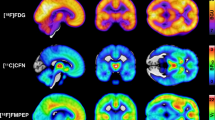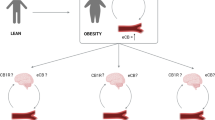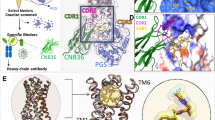Abstract
Objectives:
(1) To investigate whether modulation of the cannabinoid type 1 receptor (CB1R) directly regulates the production of adiponectin (ApN) and other adipokines in omental adipose tissue (OAT) of obese subjects, (2) to establish in which cellular fraction of OAT the effects of CB1R blockade take place and (3) to unravel the underlying mechanisms.
Subjects and methods:
OAT was obtained from 30 obese subjects (body mass index: 40.6±1.3 kg m−2) undergoing abdominal surgery. Primary cultures of explants or of freshly isolated adipocytes or stromal-vascular cells (SVCs) were used.
Results:
In OAT explants, the CB1R blocker Rimonabant upregulated ApN gene expression. mRNA abundance of omentin that exhibits insulin-sensitizing properties was upregulated as well. Conversely, mRNA levels of two pro-inflammatory cytokines, macrophage inflammatory protein (MIP)-1β and interleukin (IL)-7 were downregulated. We next examined where these effects took place within OAT. CB1R expression was similar in both cellular fractions. In isolated mature adipocytes, blockade of CB1R reproduced the increase of ApN mRNA and the decrease of IL-7 mRNA, while inducing a rise of ApN secretion into the medium. In isolated SVC, gene expression of omentin, which is restricted to this fraction, was augmented, while that of MIP-1β was diminished. Finally, we deciphered the mechanisms leading to ApN regulation by the endocannabinoid system (ES). We first established that ApN regulation was actually mediated by the CB1R: ApN gene expression was upregulated by Rimonabant and downregulated by the CB1R agonist arachidonyl-2-chloroethylamide (ACEA). Upregulation of ApN by Rimonabant was unaltered by inhibiting cAMP production. However, downregulation of ApN by ACEA was fully reversed by an inhibitor of p38 mitogen-activated protein kinase (p38MAPK) and ACEA increased p38MAPK phosphorylation.
Conclusions:
Blockade of CB1R attenuates the inflammatory state in both cellular fractions of OAT either by increasing ApN and omentin production or by decreasing mRNAs of MIP-1β and IL-7. ApN regulation by the ES partly involves p38MAPK.
This is a preview of subscription content, access via your institution
Access options
Subscribe to this journal
Receive 12 print issues and online access
$259.00 per year
only $21.58 per issue
Buy this article
- Purchase on SpringerLink
- Instant access to full article PDF
Prices may be subject to local taxes which are calculated during checkout




Similar content being viewed by others
References
Matsuzawa Y . Therapy Insight: adipocytokines in metabolic syndrome and related cardiovascular disease. Nat Clin Pract Cardiovasc Med 2006; 3: 35–42.
Guerre-Millo M . Adipose tissue and adipokines: for better or worse. Diabetes Metab 2004; 30: 13–19.
Jernas M, Palming J, Sjoholm K, Jennische E, Svensson PA, Gabrielsson BG et al. Separation of human adipocytes by size: hypertrophic fat cells display distinct gene expression. FASEB J 2006; 20: 1540–1542.
Skurk T, Alberti-Huber C, Herder C, Hauner H . Relationship between adipocyte size and adipokine expression and secretion. J Clin Endocrinol Metab 2007; 92: 1023–1033.
Scheen AJ . The endocannabinoid system: a promising target for the management of type 2 diabetes. Curr Protein Pept Sci 2009; 10: 56–74.
Muccioli GG, Naslain D, Backhed F, Reigstad CS, Lambert DM, Delzenne NM et al. The endocannabinoid system links gut microbiota to adipogenesis. Mol Syst Biol 2010; 6: 392.
Engeli S, Bohnke J, Feldpausch M, Gorzelniak K, Janke J, Batkai S et al. Activation of the peripheral endocannabinoid system in human obesity. Diabetes 2005; 54: 2838–2843.
Bluher M, Engeli S, Kloting N, Berndt J, Fasshauer M, Batkai S et al. Dysregulation of the peripheral and adipose tissue endocannabinoid system in human abdominal obesity. Diabetes 2006; 55: 3053–3060.
Matias I, Gonthier MP, Orlando P, Martiadis V, De PL, Cervino C et al. Regulation, function, and dysregulation of endocannabinoids in models of adipose and beta-pancreatic cells and in obesity and hyperglycemia. J Clin Endocrinol Metab 2006; 91: 3171–3180.
Bellocchio L, Cervino C, Pasquali R, Pagotto U . The endocannabinoid system and energy metabolism. J Neuroendocrinology 2008; 20: 850–857.
Ruilope LM, Despres JP, Scheen A, Pi-Sunyer X, Mancia G, Zanchetti A et al. Effect of rimonabant on blood pressure in overweight/obese patients with/without co-morbidities: analysis of pooled RIO study results. J Hypertens 2008; 26: 357–367.
Despres JP, Golay A, Sjostrom L . Effects of rimonabant on metabolic risk factors in overweight patients with dyslipidemia. N Engl J Med 2005; 353: 2121–2134.
Bensaid M, Gary-Bobo M, Esclangon A, Maffrand JP, Le Fur G, Oury-Donat F et al. The cannabinoid CB1 receptor antagonist SR141716 increases Acrp30 mRNA expression in adipose tissue of obese fa/fa rats and in cultured adipocyte cells. Mol Pharmacol 2003; 63: 908–914.
Pagano C, Pilon C, Calcagno A, Urbanet R, Rossato M, Milan G et al. The endogenous cannabinoid system stimulates glucose uptake in human fat cells via phosphatidylinositol 3-kinase and calcium-dependent mechanisms. J Clin Endocrinol Metab 2007; 92: 4810–4819.
Gonzalez-Muniesa P, Bing C, Trayhurn P . Upregulation of the expression of inflammatory and angiogenic markers in human adipocytes by a synthetic cannabinoid, JTE-907. Horm Metab Res 2010; 42: 710–717.
Murumalla R, Bencharif K, Gence L, Bhattacharya A, Tallet F, Gonthier MP et al. Effect of the Cannabinoid Receptor-1 antagonist SR141716A on human adipocyte inflammatory profile and differentiation. J Inflamm (Lond) 2011; 8: 33.
Hwang CS, Loftus TM, Mandrup S, Lane MD . Adipocyte differentiation and leptin expression. Annu Rev Cell Dev Biol 1997; 13: 231–259.
Maury E, Ehala-Aleksejev K, Guiot Y, Detry R, Vandenhooft A, Brichard SM . Adipokines oversecreted by omental adipose tissue in human obesity. Am J Physiol Endocrinol Metab 2007; 293: E656–E665.
Alberti KG, Eckel RH, Grundy SM, Zimmet PZ, Cleeman JI, Donato KA et al. Harmonizing the metabolic syndrome: a joint interim statement of the International Diabetes Federation Task Force on Epidemiology and Prevention; National Heart, Lung, and Blood Institute; American Heart Association; World Heart Federation; International Atherosclerosis Society; and International Association for the Study of Obesity. Circulation 2009; 120: 1640–1645.
Halleux CM, Declerck PJ, Tran SL, Detry R, Brichard SM . Hormonal control of plasminogen activator inhibitor-1 gene expression and production in human adipose tissue: stimulation by glucocorticoids and inhibition by catecholamines. J Clin Endocrinol Metab 1999; 84: 4097–4105.
Maury E, Noel L, Detry R, Brichard SM . In vitro hyperresponsiveness to tumor necrosis factor-alpha contributes to adipokine dysregulation in omental adipocytes of obese subjects. J Clin Endocrinol Metab 2009; 94: 1393–1400.
Hsu HF, Tsou TC, Chao HR, Shy CG, Kuo YT, Tsai FY et al. Effects of arecoline on adipogenesis, lipolysis, and glucose uptake of adipocytes-A possible role of betel-quid chewing in metabolic syndrome. Toxicol Appl Pharmacol 2010; 245: 370–377.
Patel NG, Holder JC, Smith SA, Kumar S, Eggo MC . Differential regulation of lipogenesis and leptin production by independent signaling pathways and rosiglitazone during human adipocyte differentiation. Diabetes 2003; 52: 43–50.
Xu A, Wong LC, Wang Y, Xu JY, Cooper GJ, Lam KS . Chronic treatment with growth hormone stimulates adiponectin gene expression in 3T3-L1 adipocytes. FEBS Lett 2004; 572: 129–134.
Halleux CM, Servais I, Reul BA, Detry R, Brichard SM . Multihormonal control of ob gene expression and leptin secretion from cultured human visceral adipose tissue: increased responsiveness to glucocorticoids in obesity. J Clin Endocrinol Metab 1998; 83: 902–910.
Delaigle AM, Jonas JC, Bauche IB, Cornu O, Brichard SM . Induction of adiponectin in skeletal muscle by inflammatory cytokines: in vivo and in vitro studies. Endocrinology 2004; 145: 5589–5597.
Yang RZ, Lee MJ, Hu H, Pray J, Wu HB, Hansen BC et al. Identification of omentin as a novel depot-specific adipokine in human adipose tissue: possible role in modulating insulin action. Am J Physiol Endocrinol Metab 2006; 290: E1253–E1261.
Turu G, Hunyady L . Signal transduction of the CB1 cannabinoid receptor. J Mol Endocrinol 2010; 44: 75–85.
Lofgren P, Sjolin E, Wahlen K, Hoffstedt J . Human adipose tissue cannabinoid receptor 1 gene expression is not related to fat cell function or adiponectin level. J Clin Endocrinol Metab 2007; 92: 1555–1559.
Hillard CJ, Manna S, Greenberg MJ, DiCamelli R, Ross RA, Stevenson LA et al. Synthesis and characterization of potent and selective agonists of the neuronal cannabinoid receptor (CB1). J Pharmacol Exp Ther 1999; 289: 1427–1433.
Moreno-Navarrete JM, Catalan V, Whyte L, Diaz-Arteaga A, Vazquez-Martinez R, Rotellar F et al. The L-alpha-lysophosphatidylinositol/GPR55 system and its potential role in human obesity. Diabetes 2012; 61: 281–291.
Henstridge CM, Balenga NA, Schroder R, Kargl JK, Platzer W, Martini L et al. GPR55 ligands promote receptor coupling to multiple signalling pathways. Br J Pharmacol 2010; 160: 604–614.
de Souza Batista CM, Yang RZ, Lee MJ, Glynn NM, Yu DZ, Pray J et al. Omentin plasma levels and gene expression are decreased in obesity. Diabetes 2007; 56: 1655–1661.
Tan BK, Adya R, Farhatullah S, Chen J, Lehnert H, Randeva HS . Metformin treatment may increase omentin-1 levels in women with polycystic ovary syndrome. Diabetes 2010; 59: 3023–3031.
Yamawaki H, Tsubaki N, Mukohda M, Okada M, Omentin Hara Y . a novel adipokine, induces vasodilation in rat isolated blood vessels. Biochem Biophys Res Commun 2010; 393: 668–672.
Alexander CM, Selvarajan S, Mudgett J, Werb Z . Stromelysin-1 regulates adipogenesis during mammary gland involution. J Cell Biol 2001; 152: 693–703.
Lijnen HR, Demeulemeester D, Van Hoef B, Collen D, Maquoi E . Deficiency of tissue inhibitor of matrix metalloproteinase-1 (TIMP-1) impairs nutritionally induced obesity in mice. Thromb Haemost 2003; 89: 249–255.
Scroyen I, Cosemans L, Lijnen HR . Effect of tissue inhibitor of matrix metalloproteinases-1 on in vitro and in vivo adipocyte differentiation. Thromb Res 2009; 124: 578–583.
Meissburger B, Stachorski L, Roder E, Rudofsky G, Wolfrum C . Tissue inhibitor of matrix metalloproteinase 1 (TIMP1) controls adipogenesis in obesity in mice and in humans. Diabetologia 2011; 54: 1468–1479.
Hartgring SA, Bijlsma JW, Lafeber FP, van Roon JA . Interleukin-7 induced immunopathology in arthritis. Ann Rheum Dis 2006; 65 (Suppl 3): iii69–iii74.
Maurer M, von Stebut E . Macrophage inflammatory protein-1. Int J Biochem Cell Biol 2004; 36: 1882–1886.
Gary-Bobo M, Elachouri G, Scatton B, Le Fur G, Oury-Donat F, Bensaid M . The cannabinoid CB1 receptor antagonist rimonabant (SR141716) inhibits cell proliferation and increases markers of adipocyte maturation in cultured mouse 3T3 F442A preadipocytes. Mol Pharmacol 2006; 69: 471–478.
Delporte ML, Funahashi T, Takahashi M, Matsuzawa Y, Brichard SM . Pre- and post-translational negative effect of beta-adrenoceptor agonists on adiponectin secretion: in vitro and in vivo studies. Biochem J 2002; 367 (Part 3): 677–685.
Tedesco L, Valerio A, Dossena M, Cardile A, Ragni M, Pagano C et al. Cannabinoid receptor stimulation impairs mitochondrial biogenesis in mouse white adipose tissue, muscle, and liver: the role of eNOS, p38 MAPK, and AMPK pathways. Diabetes 2010; 59: 2826–2836.
Author information
Authors and Affiliations
Corresponding author
Ethics declarations
Competing interests
SMB received grants from Sanofi-Aventis, Diegem, Belgium. The remaining authors declare no conflict of interest.
Rights and permissions
About this article
Cite this article
Ge, Q., Maury, E., Rycken, L. et al. Endocannabinoids regulate adipokine production and the immune balance of omental adipose tissue in human obesity. Int J Obes 37, 874–880 (2013). https://doi.org/10.1038/ijo.2012.123
Received:
Revised:
Accepted:
Published:
Issue date:
DOI: https://doi.org/10.1038/ijo.2012.123
Keywords
This article is cited by
-
Deletion of G-protein-coupled receptor 55 promotes obesity by reducing physical activity
International Journal of Obesity (2016)



